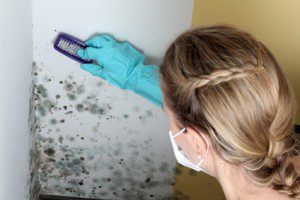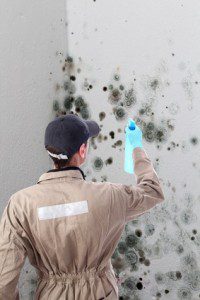Mold Removal Costs and Money Saving Tips
MoldMold is a type of fungus that grows in damp or humid conditi... More and mildewMildew is a type of fungus that grows on damp surfaces, typi... More is never a welcomed guest in anyone’s home. It starts to grow within dark damp places and can become a surprise if you are not prepared for it. If you do not catch this rapidly growing fungus in time, it can cost you exponentially. Being ready to clean the moldMold is a type of fungus that grows in damp or humid conditi... More problem as well as knowing mold removal costs will help you be prepared in the long run.
Often times, many people can clean moldMold is a type of fungus that grows in damp or humid conditi... More problems on their own. This can be done with store bought solutions or home made remedies to remove small areas of moldMold is a type of fungus that grows in damp or humid conditi... More. Yet often times, if the area is too large or the moldMold is a type of fungus that grows in damp or humid conditi... More to dangerous, a mold removal specialist may need to come in and clean.
Mold Types

MoldMold is a type of fungus that grows in damp or humid conditi... More Removal
In order to safely clean your moldMold is a type of fungus that grows in damp or humid conditi... More problem, you should have some information on the types of moldMold is a type of fungus that grows in damp or humid conditi... More that can grow within your home.
MoldMold is a type of fungus that grows in damp or humid conditi... More sporesSpores are microscopic reproductive units of fungi or mold t... More and allergenic moldMold is a type of fungus that grows in damp or humid conditi... More are generally not harmful, but can be dangerous to people with asthma and immune problems. Usually these types of moldMold is a type of fungus that grows in damp or humid conditi... More can be easily removed without future problems.
Mycotoxic moldMold is a type of fungus that grows in damp or humid conditi... More sporesSpores are microscopic reproductive units of fungi or mold t... More are those containing toxins in the cell wall. This type of moldMold is a type of fungus that grows in damp or humid conditi... More can be harmful to you and your family’s health. It can cause immune diseases, cancer or even death in some cases. This type of moldMold is a type of fungus that grows in damp or humid conditi... More should never be handled alone. Cleaning such toxic moldMold is a type of fungus that grows in damp or humid conditi... More should be handled by a professional cleaning service. See the link below to find a service near you.
Pathogenic moldMold is a type of fungus that grows in damp or humid conditi... More is the type that can cause infectionInfection is the invasion and multiplication of harmful micr... More. It can affect anyone who has suppressed immune diseases, those with autoimmune disease or anyone taking chemotherapy. This moldMold is a type of fungus that grows in damp or humid conditi... More should again, not be tackled on your own.
Mold Removal Costs
If you decide to clean your moldMold is a type of fungus that grows in damp or humid conditi... More problem on your own, make sure it’s safe to proceed. The EPA suggests that an area of no more than 10 square feet can be cleaned on your own. If the area is larger than that, calling a professional is necessary to stay safe.
Drywall Mold Removal
MoldMold is a type of fungus that grows in damp or humid conditi... More is commonly found on drywall and along baseboards. Outside walls can carry more moisture, thus leading to moldMold is a type of fungus that grows in damp or humid conditi... More growth within the walls. If the moldMold is a type of fungus that grows in damp or humid conditi... More is confined to a small space you generally won’t have to cut the entire drywall out.
Cutting out a small portion of the drywall will help prevent the moldMold is a type of fungus that grows in damp or humid conditi... More from spreading to surrounding walls. To remove a small section of drywall, you will need:
– A small saw or X-acto knife
– Sand Paper
– Scrub brush
– Patch Kit
– MoldMold is a type of fungus that grows in damp or humid conditi... More Removal and DisinfectantA disinfectant is a chemical substance used to kill or inact... More (Store bought or homemade bleach solutionA solution is a homogeneous mixture of two or more substance... More)
When cutting out the molded drywall, make sure to add a couple of inches outside the moldMold is a type of fungus that grows in damp or humid conditi... More to ensure to no sporesSpores are microscopic reproductive units of fungi or mold t... More are left behind. Once the drywall is removed, sand the edges of the drywall and any surrounding studs that may contain moldMold is a type of fungus that grows in damp or humid conditi... More. You then can apply the mold removal to the studs and along the edges of drywall. Make sure to apply to all reachable areas to ensure proper cleaning. Once the area is dry, you can then use your patch kit to repairRepair is the act of fixing or restoring damaged property, m... More the wall. The estimated cost of removing a piece of drywall is around $25.
Upholstery Mold Removal
Higher humidityHumidity is the amount of moisture or water vapor present in... More climates can cause your home to retain a lot more moisture. This moisture can settle into walls, floors and even your furniture, your upholstery being a popular home for moisture and moldMold is a type of fungus that grows in damp or humid conditi... More sporesSpores are microscopic reproductive units of fungi or mold t... More.
To keep you furniture and upholstery dry, make sure to keep a ventilated home with fans or opened windows. Once fabric and wood become wet, moldMold is a type of fungus that grows in damp or humid conditi... More can start to grow within 2 days. Air conditioning also tends to dry out your home’s air.

Mold RemediationMold remediation is the process of identifying, removing, an... More
If fabrics can be removed and washed, make sure to do this frequently to prevent fungus from growing on the surface. Laundry detergent and the heat from the dryer should eliminate the moldMold is a type of fungus that grows in damp or humid conditi... More sporesSpores are microscopic reproductive units of fungi or mold t... More. If you cannot remove the fabric, place the furniture outside to prevent the sporesSpores are microscopic reproductive units of fungi or mold t... More from traveling. Vacuum up the molded area to remove as many sporesSpores are microscopic reproductive units of fungi or mold t... More as possible; you then can apply a mild rubbing alcohol, water mixture to the infected area. The alcohol should kill the sporesSpores are microscopic reproductive units of fungi or mold t... More while the sun dries the fabric. This cleaning solutionA solution is a homogeneous mixture of two or more substance... More should only cost around $2, yet if the moldMold is a type of fungus that grows in damp or humid conditi... More has spread within the furniture, you may need to take it to a mold remediation specialist. Most places provide free estimates and quotes.
Bathroom Mold Removal
Bathrooms are some of the most popular places to find moldMold is a type of fungus that grows in damp or humid conditi... More. High humidityHumidity is the amount of moisture or water vapor present in... More combined with the constant contact with water provides an optimum place for moldMold is a type of fungus that grows in damp or humid conditi... More to grow. Since bathroom moldMold is a type of fungus that grows in damp or humid conditi... More generally grows on hard surfaces such as tiles, it can be a little easier to remove on your own.
The first thing to remember is to always wear protective gear, such as plastic gloves and a facemask. By combining a 50/50 solutionA solution is a homogeneous mixture of two or more substance... More of water and bleach, this mixture can kill moldMold is a type of fungus that grows in damp or humid conditi... More sporesSpores are microscopic reproductive units of fungi or mold t... More growing on the surface. Apply to tiles, grout and any little crevice that moldMold is a type of fungus that grows in damp or humid conditi... More may grow. To keep moldMold is a type of fungus that grows in damp or humid conditi... More from coming back, always wipe down shower walls after use and apply this solutionA solution is a homogeneous mixture of two or more substance... More every month to keep it disinfected. The solutionA solution is a homogeneous mixture of two or more substance... More should cost you around $2 for the bleach.
Mold Removal Service
Often times people cannot identify the type of moldMold is a type of fungus that grows in damp or humid conditi... More that is growing or how far it has traveled. Be sure to call a professional to ensure it is safe to enter your home. Many mold remediation specialists will provide free estimates on moldMold is a type of fungus that grows in damp or humid conditi... More removal and will discuss prices depending on the size of the job.
If you need mold removal services, call a local service provider near you today.












